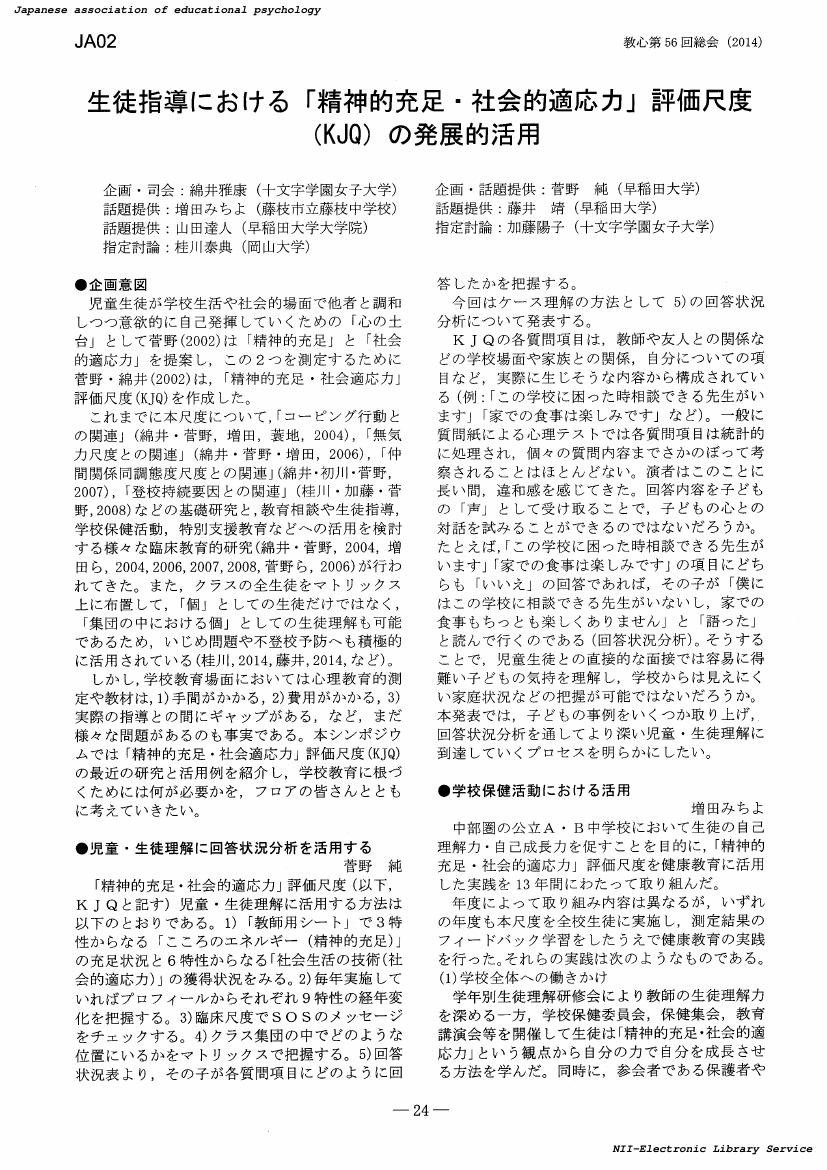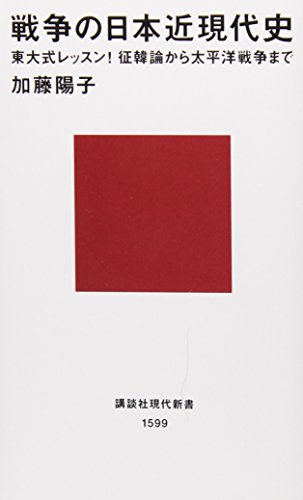1 0 0 0 OA シカ肉に含まれるカルニチンおよびそのアシル化体含有量の加熱調理による影響
- 著者
- 山下 麻美 加藤 陽二 吉村 美紀
- 出版者
- 公益社団法人 日本食品科学工学会
- 雑誌
- 日本食品科学工学会誌 (ISSN:1341027X)
- 巻号頁・発行日
- vol.61, no.4, pp.178-181, 2013-04-10 (Released:2014-05-31)
- 参考文献数
- 16
本研究では,シカ肉の機能性食品としての活用を目的として,シカ肉の加熱調理によるカルニチン含有量の変化について検討を行った.加熱調理により,親水性であるL-カルニチンは,煮る調理加熱とスチーム加熱において,肉汁とともに溶出したため損失傾向を示した.疎水性であるアシルカルニチン類は,揚げる調理加熱を除いて,加熱調理により濃縮し,増加傾向を示した.アセチルカルニチンにおいてのみ,ヘキサノイルカルニチン,ミリストイルカルニチン,パルミトイルカルニチンほどの増加傾向は示さず,損失傾向を示す調理加熱方法もあった.アセチルカルニチンは,疎水性ではあるものの低分子であることが影響していると推察される.腸内細菌による代謝物を介して,アテローム性動脈硬化を引き起こす可能性が示唆されているL-カルニチンが,加熱調理により損失することで,疾病の予防につながることも考えられる.また,脳機能向上などの機能性が示唆されているアセチルカルニチンが加熱調理により損失せず,生肉の状態と同程度の含有量を保持する調理方法が望ましいと考えられる.これらの事より,本実験の加熱調理方法の中では,スチーム加熱がシカ肉の機能性食品としての活用を促進する上で,最も有効であると推察される.
1 0 0 0 トナリのシガク(8)国際政治の今と日英関係
- 著者
- 加藤 陽子
- 出版者
- 東京大学出版会
- 雑誌
- UP (ISSN:09133291)
- 巻号頁・発行日
- vol.41, no.8, pp.44-49, 2012-08
1 0 0 0 トナリのシガク(28)帝政ロシア、ソ連、ロシア
- 著者
- 加藤 陽子
- 出版者
- 東京大学出版会
- 雑誌
- UP (ISSN:09133291)
- 巻号頁・発行日
- vol.47, no.11, pp.36-41, 2018-11
- 著者
- 加藤 陽子
- 出版者
- 東洋経済新報社
- 雑誌
- 週刊東洋経済 = Weekly toyo keizai (ISSN:09185755)
- 巻号頁・発行日
- no.6680, pp.118-119, 2016-09-10
1 0 0 0 大会講演 昭和戦前期の岐路と日本の選択
- 著者
- 加藤 陽子
- 出版者
- 日本大学史学会
- 雑誌
- 史叢 (ISSN:03869423)
- 巻号頁・発行日
- no.96, pp.1-17, 2017-03
- 著者
- 加藤 陽子
- 出版者
- 山川出版社
- 雑誌
- 歴史と地理 (ISSN:13435957)
- 巻号頁・発行日
- no.712, pp.27-33, 2018-03
1 0 0 0 対談 戦争体験を"経験化"する語り (特集 戦争を考える)
- 著者
- 奥泉 光 加藤 陽子
- 出版者
- 集英社
- 雑誌
- すばる (ISSN:03876381)
- 巻号頁・発行日
- vol.41, no.8, pp.118-133, 2019-08
- 著者
- 綿井 雅康 菅野 純 増田 みちよ 藤井 靖 山田 達人 加藤 陽子 桂川 泰典
- 出版者
- 一般社団法人 日本教育心理学会
- 雑誌
- 日本教育心理学会総会発表論文集 第56回総会発表論文集 (ISSN:21895538)
- 巻号頁・発行日
- pp.24-25, 2014-10-26 (Released:2017-03-30)
1 0 0 0 OA マヌカ蜂蜜に含まれるケミカルマーカーと認証評価
- 著者
- 加藤 陽二
- 出版者
- 公益社団法人 日本農芸化学会
- 雑誌
- 化学と生物 (ISSN:0453073X)
- 巻号頁・発行日
- vol.55, no.5, pp.313-318, 2017-04-20 (Released:2018-04-20)
- 参考文献数
- 21
食の偽装は世界的にも大きな問題である.産地偽装は今も昔も頻繁に起きており,輸入物を国産品と偽るなど,枚挙に暇がない.違う食材を用いる例も多い.エビの場合,ブラックタイガーを車エビ,バナメイエビを芝エビ,ロブスターを伊勢エビと偽って表示するなど,毎日のように新聞各紙に取り上げられていたことは記憶に新しい.食の偽装を防ぐために,さまざまな取り組みがなされているが,本稿では例として蜂蜜,なかでもマヌカ蜂蜜を主として取り上げ,偽装を防ぐための認証評価法について紹介する.マヌカ蜂蜜に限らず蜂蜜は,加糖(希釈)や加熱,産地のすり替えなど,以前より偽装が疑われる例の多い食材と言える.
1 0 0 0 OA 腸管出血性大腸菌O157:H7に対するこんにゃく液の殺菌作用
- 著者
- 北元 憲利 田中 智之 加藤 陽二 辻 啓介
- 出版者
- 日本食品化学学会
- 雑誌
- 日本食品化学学会誌 (ISSN:13412094)
- 巻号頁・発行日
- vol.7, no.2, pp.86-92, 2000-10-28 (Released:2017-12-01)
- 参考文献数
- 13
こんにゃくは、水酸化カルシウム溶液に浸されたアルカリ性を呈する食品であるが、腸管出血性大腸菌O157との関わりを検討した報告はない。そこで、本研究では、こんにゃく液中におけるO157の生存状況と、こんにゃく液の抗菌効果(静菌作用あるいは殺菌作用)について検討した。こんにゃく液はいずれもpH12前後であり、この高いpH域では、O157は反応させるだけで検出限界までに激減することがわかった。初発菌数が多い場合でも1日の反応(保存)でほとんどが死滅した。また、この抗菌作用は大腸菌の株による違いや温度差には影響されなかった。一方、食中毒菌であるサルモネラ菌、腸炎ビブリオ菌および黄色ブドウ球菌についても同様に比較検討したところ、こんにゃくの液の抗菌効果は、O157と比べると同等かあるいはやや弱いようであった。しかし、これらの食中毒菌もこんにゃく液中では時間とともに減少し、2〜3日後ではほとんどが死滅することが判明した。さらに、市販こんにゃく液中の細菌の存在有無を検討したが、調べた限り、開封直後のこんにゃく液中には菌は検出されなかった。以上の結果から、こんにゃく液は衛生学的に安全性の高いことが証明され、静菌作用(菌の増殖抑制・阻害作用)というよりは、殺菌作用(生菌数の低減化作用)をもつことが明らかとなった。こんにゃくのような高アルカリ性呈示食品は、少数の生菌数の摂取でも発症するような腸管出血性大腸菌O157などの感染症防止に対しても、大きな役割を果たしているものと考えられる。
1 0 0 0 OA Ca-6 ヒアルコPG^[○!R](ヒアルロン酸-コラーゲン-プロテオグリカン複合体)の新規抽出法の確立と食品への利用(糖質の構造・合成-2,一般講演,日本応用糖質科学会平成26年度大会(第63回))
- 著者
- 末川 裕 後藤 昌史 山本 和司 加藤 陽治
- 出版者
- 一般社団法人 日本応用糖質科学会
- 雑誌
- 応用糖質科学:日本応用糖質科学会誌 (ISSN:21856427)
- 巻号頁・発行日
- vol.4, no.3, pp.B47, 2014-08-20 (Released:2018-01-25)
1 0 0 0 IR テ形節分類の一試案 : 従属度を基準として
- 著者
- 加藤 陽子 Yoko KATO 国際大学日本語プログラム International University of Japan
- 雑誌
- 世界の日本語教育. 日本語教育論集 = Japanese language education around the globe ; Japanese language education around the globe (ISSN:09172920)
- 巻号頁・発行日
- no.5, pp.209--224, 1995-04-28
本稿は、用言のテ形(書いて、白くて、静かで、など)で接続されている複文を、従属節の主節に対する依存の程度(従属度)の違いによって分類することを目的とした。その従属度を測定する基準の一つとして、「主節末のモダリティや否定辞のスコープによる複文の構造」という統語的側面 を考察した。これらのスコープを観察することで、複文は、主節末のスコープが主節命題と従属節命題まで及ぶ構造(α構造)と、主節末のスコープが主節の命題のみにしか及ばない構造(β構造)に分けられた。本稿では、このα・βの構造の違いが、従属度を反映し、分類の統語的基準になると考えた。また、従属度を測定するもう一つの基準として、「節間の関係的意味を成立させる要素」という意味的な側面 を考えた。この要素は、(1)従属節の、複文全体における命題形成の機能、(2)主節・従属節間の論理関係、(3)主節・従属節間の時間・順序関係、(4)主節・従属節の述語の主語の異同、の四つである。本稿では、これらの要素が相互に関連しながら緊密に節同士が関係しあって複文を構成するものを従属度の高いテ形、これらの要素間にあまり関係がなく、節間の緊密な関係もみられないものを従属度の低いテ形、とした。この二つの基準から、テ形節は、テ1(付帯状況)、テ2(継起的動作)、テ3(原因・理由)、テ4(並列)、テ5(発言のモダリティ成分)に分類され、テ1からテ5の順番で、従属度が低くなっていくことを述べた。
- 著者
- 加藤 陽子
- 出版者
- 一般財団法人 日本国際政治学会
- 雑誌
- 国際政治 (ISSN:04542215)
- 巻号頁・発行日
- vol.1995, no.109, pp.110-125,L12, 1995
At the end of the Pacific War, there were more than 6 million Japanese (this figure includes not only military and naval personnel but olso civilians) scattered in overseas theaters; Korea, Manchuria, China, the Philippine islands, and the islands of the Western Pacific. At that moment, there was no one who dared imagine that Japanese nationals overseas could get back home safely and smoothly.<br>But in fact, 90 percent of them were repatriated by the end of 1949. In particular, 80 percent of the Japanese in former Japanese occupied territory in China, could return by May 1946.<br>This paper focuses on how the disarmament and repatriation policies for the Japanese overseas were made, and why they could be repatriated so quickly.<br>Who had the supreme responsibility to accomplish the disarmament of Japanese nationals and to provide for their repatriation? The Chinese National government troops under Chiang Kai-shek's rule could not carry out this mission. During the anti-Japanese War, the Nationalist government moved into the western regions, far from the coastal araes, so it took time for them to reach Japanese occupied territory.<br>Only the United States had the power and will to govern all the processes of repatriation. But at the same time, she had to solve other problems. First, she was supposed to maintain the pace of her own demobilization. There was strong pressure to bring Americans out of China. Second, she had to consider Manchurian problems. Generalissimo Chiang asked United States to transfer his army to the northern part of China, as quickly as possible, or the Soviet and Chinese Communist Party would have enterd into the vacuum.<br>In short, the repatriation of Japanese, demobilization of Americans, and transportation of Chinese were absolutely necessary for Washington. In order to carry out all these programs, the Joint Chiefs of Staff mapped out detailed plans for navigating large numbers of LST and Liberty vessels in December 1945.
- 著者
- 加藤 陽子
- 出版者
- 公益財団法人史学会
- 雑誌
- 史學雜誌 (ISSN:00182478)
- 巻号頁・発行日
- vol.96, no.8, pp.1257-1291, 1407-1408, 1987-08-20
Dai Hon'ei 大本営 (Imperial Military Headquarters) refers to the highest office organizing wartime military operations. This office was set up in the 1894 Sino-Japanese War, the Russo-Japanese War, and the War with China which extended into the Pacific War. This paper deals with Dai Hon'ei established at the beginning of the War with China in November, 1937. It has been said that the Dai Hon'ei was very much the same in function as its Russo-Japanese War counterpart, or that it was merely a kind of the General Staff Office whose function was reorganized to meet the demands the war. World War I, as the first total war in human history, however, must have greatly influenced Japanese military authorities and stimulated them to study seriously the war tactics and the wartime systems of the participating countories. We may therefore conclude that the Japanese military authorities took into consideration the results of this careful study when establishing the third Dai Hon'ei. Based on this assumption, this paper discusses the formation process and characteristics of the Dai Hon'ei during the Japan-China War. The first chapter discusses the great changes which took place in the Dai Hon'ei set up in the Japan-China War in comparison with its predecessors. At the time of establishment it increased the authority of such military administrative authorities as the army minister, the vice minister, the director and the chief of military affairs, and the military chief, vis-a-vis the supreme command authorities. The Dai Hon'ei's functional emphasis on the military administrative authorities theoretically should have caused the Prime Minister to be concerned with the Dai Hon'ei, since the army minister was also Minister of State. What leads us to believe that more emphasis was now being placed on the minltary administration is the recognition that in the case of total war the administration and the supreme command should not be separated, but unified in terms of policy and strategy. The second chapter examines the fact that the establishment of the Dai Hon'ei was not an isolated decision, but was made in relation with the Councillor System (Shangi-Sei 参議制), which was created by the government during roughly the same period, and was regarded as a cause of those government reforms which went as far as to totally revamp the cabinet system. Therefore it becomes clear that Konoe Fumimaro and the military authorities attemped to reform the government at the time of the establishment of the Dai Hon'ei, out of consideration that any dualism between state affiars and the military command would cause severe limitations on war mobilization efforts. While the move to the separate the Ministry of State from the Director of the Administrative Affairs was not realized, the successful establishment of the Sangi-Sei, was significant in empowering a minister without portfolio (Muninsho-Daijin-Sei 無任所大臣制). By including the unrealized cabinet reformation plan in the discussion, this paper emphsizes that the establishment of the Dai Hon'ei in the Japan-China War played a number of important roles not only in improving the capabilities for meeting the war demands, but also by being part of the reform plan for a wartime government system.
1 0 0 0 脳卒中片麻痺患者の下肢装具作製時期が入院日数に及ぼす影響について
- 著者
- 伊藤 祥江 髙木 聖 小川 優喜 瀧野 皓哉 早藤 亮兵 川出 佳代子 今村 隼 稲垣 潤一 林 由布子 中村 優希 加藤 陽子 森 紀康 鈴木 重行 今村 康宏
- 出版者
- JAPANESE PHYSICAL THERAPY ASSOCIATION
- 雑誌
- 日本理学療法学術大会
- 巻号頁・発行日
- vol.2010, pp.BbPI1176-BbPI1176, 2011
【目的】2000年に回復期リハビリテーション病棟(以下、リハ病棟)制度が創設され、医療施設の機能分化が進められた。急性期病院における在院日数は短縮され、長期の入院を必要とする脳卒中片麻痺患者はリハ病棟を有する病院への転院を余儀なくされる。脳卒中ガイドラインにおいては早期リハを積極的に行うことが強く勧められており、その内容には下肢装具を用いての早期歩行訓練も含まれている。しかし、装具処方から完成までには通常1~2週間を要することなどから、急性期病院における片麻痺患者に対する積極的な早期装具処方は容易ではなく、装具適応患者に対する装具処方のほとんどが、リハ病棟転院後に行われているのが実情であろう。その結果、歩行能力の改善が遅れ、入院期間が長くなっていることが推測される。当院は人口約14万7千人の医療圏における中核病院で、平成18年にリハ病棟を開設した。現在は当院一般病棟からの転棟患者ならびに近隣の救急病院からの転院患者も広く受け入れている。今回われわれは、当院リハ病棟に入院した脳卒中片麻痺患者において、下肢装具作製時期が発症から退院までの日数におよぼす影響について検討したので若干の考察とともに報告する。<BR>【方法】平成18年12月から平成22年7月までの間に当院リハ病棟に入院し、理学療法を施行した初回発症の脳卒中片麻痺患者のうち、下肢装具を作製した32例を対象とした。内訳は脳梗塞25例、脳出血7例、男性15例、女性17例、右麻痺13例、左麻痺19例、平均年齢69.5±13.3歳であった。当院の一般病棟からリハ病棟に転棟した群(以下、A群)と他院での急性期治療後に当院リハ病棟に入院した群(以下、B群)の2群に分けた。これら2群について(1)作製した装具の内訳ならびに(2)発症から当院リハ病棟退院までの日数について調査した。また、(2)に含まれる1)発症から装具採型までの日数、2)発症からリハ病棟入院までの日数、3)リハ病棟入院から装具採型までの日数、4)リハ病棟入院から退院までの日数の各項目についても合わせて調査した。2群間の比較は対応のないt検定を用いて行い、5%未満を有意な差と判断した。<BR>【説明と同意】本研究はヘルシンキ宣言をもとに実施し、収集した個人情報は当院の個人情報保護方針をもとに取り扱っている。<BR>【結果】(1)A群は長下肢装具(以下、KAFO)3例、金属支柱付短下肢装具(以下、支柱AFO)13例、プラスチック製短下肢装具(以下、P-AFO)1例であった。B群はKAFO2例、支柱AFO6例、P-AFO7例であった。(2)A群で137.2±32.5日、B群では166.8±30.2日でA群の方が有意に短かった。(2)-1)A群で22.5±9.8日、B群では48.2±12.4日でA群の方が有意に短かった。(2)-2)A群で21.9±7.3日、B群では33.8±11.3日でA群の方が有意に短かった。(2)-3)A群で0.65±9.8日、B群では14.5±7.1日でA群の方が有意に短かった。(2)-4)A群で115.2±31.5日、B群では131.5±32.3日でA群の方が短かったが、有意差はみられなかった。<BR>【考察】本研究では、装具作製時期ならびにリハ病棟入院時期に着目し、発症からリハ病棟退院までを4つの期間に分けて入院日数との関連について検討した。その結果、リハ病棟入院日数においては両群間に差はなかったが、A群においてはリハ病棟転棟とほぼ同時期に装具の採型がされており、発症からの日数も有意に短かった。このことから、早期の装具処方によりリハ病棟転棟後もリハが途絶えることなく継続することが可能で、早期に歩行が獲得できたものと思われる。その結果、発症から退院までの期間を短縮したと考えられる。一方、B群においてはリハ病棟入院時期のみならず装具作製時期も有意に遅かった。リハ病棟入院日数にはA群と差がなかったことから、作製時期が発症から退院までの日数に影響をおよぼしたものと考えられる。急性期病院においては在院日数の短縮、作製途中での転院の可能性、また義肢装具士の来院頻度など積極的な装具作製を妨げる多くの要因があることが推測される。近年、急性期病院において装具が作製されることは少なく、リハ病院での作製件数が増加傾向にあること、また、リハ病棟が急性期にシフトしてきていることが報告されている。B群では当院リハ病棟転院から装具採型まで約2週間要していたことから、今後は転院後早期から装具処方について検討する必要があろう。2007年から連携パスが運用され始めている。それが単なる情報提供に留まらず、片麻痺患者に対する早期の装具処方、スムーズなリハの継続、そして早期の在宅復帰につながるよう連携することが必要であろう。<BR>【理学療法学研究としての意義】脳卒中発症後の早期装具作製は早期歩行獲得、在院日数の短縮に結びつく。それを推進するための地域連携について考えるものである。


